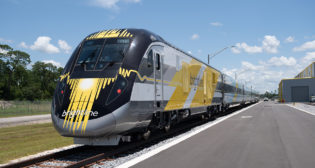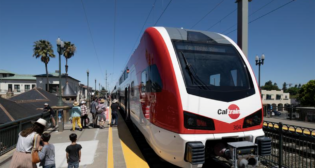
Transit Briefs: SFMTA, PANYNJ/PATH, STM, Amtrak
Written by Carolina Worrell, Senior Editor
(STM photo)
The San Francisco Municipal Transportation Agency (SFMTA) approves its Fiscal Year (FY) 2025 and FY 2026 operating and capital budgets. Also, the Port Authority of New York and New Jersey’s (PANYNJ) new tap-to-pay fare payment system is now available at all PATH stations in New Jersey; the Société de transport de Montréal (STM) releases its 2023 Annual Report; and Amtrak issues two Requests for Information (RFIs) to support high-speed Wi-Fi connectivity along the Northeast Corridor (NEC).
SFMTA
On Tuesday, April 16, the SFMTA Board of Directors unanimously approved the agency’s FY 2025 and FY 2026 operating and capital budgets. The consolidated budget has been sent to the mayor’s office for review before heading to the Board of Supervisors for final review. The Board may allow the budget to take effect without any action or it may reject it.
With the budget, SFMTA says it will continue to provide:
- “Transit service on 72 Muni routes.
- “Improvement projects that help make Muni safer, cleaner, faster and more reliable.
- “Paratransit service for half a million seniors and people with disabilities every year.
- “Street safety programs and projects like new street designs that make our roads safer for everyone.”
Reducing Budget Gap to Preserve Critical Services
In December 2022, SFMTA projected a $214 million budget gap for the upcoming two-year budget. The agency says it worked hard to shrink this gap by “reducing the agency’s expenses, making processes more efficient and limiting hiring to key positions.” By December 2023, the agency reduced the budget gap to $12.7 million.
To close the remainder of the gap, the Board had to make difficult decisions. “Our revenues still haven’t recovered from the economic impacts of the pandemic. So, we have to raise revenues to avoid cutting programs or services San Franciscans need and deserve,” SFMTA said.
Incorporating Community Feedback
“Community input was invaluable as we developed the budget, and it shaped the final version that our Board approved,” said SFMTA, which held two citywide listening sessions and 35 meetings with neighborhood groups, merchant associations and community-based organizations. The agency also heard from the public at its Board meetings from January through April.
In response to that input, SFMTA says it modified its original proposal for generating the $12.7 million needed to close the budget gap. The budget now includes “modest” increases to Muni fares, fees and fines. These increases, SFMTA says, “will protect vulnerable populations and improve fare equity,” as well as “support the future financial health of the agency.”
DOWNLOAD THE SFMTA’s APRIL BUDGET PRESENTATION BELOW:
PANYNJ/PATH
PANYNJ announced May 2 that PATH customers at all seven New Jersey stations can now use the commuter rail’s new tap-to-pay fare payment system, following the activation of new Total Access PATH Payment (TAPP) readers last week at the PATH Newport station. TAPP is now available at nine stops across the system at select turnstiles, including the World Trade Center (WTC) and 33rd Street terminals. More than 100 gates have now been equipped with TAPP readers.
PATH launched the TAPP fare payment system in December 2023 with new tap-to-pay readers at the Journal Square and 33rd Street stations. The modern contactless system, PANYNJ says, allows riders to use contactless debit/credit cards or digital wallets on smartphones at TAPP-enabled turnstiles. The open-loop system eliminates the need to purchase a specific PATH-issued fare card, such as SmartLink or pay-per-ride MetroCards. During the phase-in process, and for a period of time thereafter, turnstiles supporting both SmartLink and MetroCard will remain operational as more customers become familiar with the new TAPP system. All existing SmartLink fare discounts will be available on TAPP when TAPP is fully implemented throughout the PATH system.
In addition to the WTC and 33rd Street stations, the seven New Jersey PATH stations with TAPP turnstiles serve more than 90% of PATH’s total ridership, according to PANYNJ. With the activation of four new TAPP-enabled readers this week at the Newport station, nearly 30% of PATH’s 337 turnstiles systemwide now accept TAPP as fare payment. So far, more than two million riders have TAPPed into the system.
“We are thrilled to offer our TAPP contactless fare payment technology at our New Jersey stations, which serve the vast majority of PATH riders who will enjoy the benefit and ease of tapping in and getting on with their day,” said PANYNJ Chairman Kevin O’Toole. “As more PATH stations come online with TAPP throughout this year, the distance between New York and New Jersey will soon shrink from a river to just a tap away.”
According to PANYNJ, more TAPP-enabled turnstiles are being installed gradually throughout the system. Earlier this April, PATH added TAPP readers to turnstiles at the Grove Street and Exchange Place stations. TAPP will launch at the remaining New York stations—Christopher Street, 9th Street, 14th Street and 23rd Street—by the end of the summer.
The rollout of TAPP comes as the PATH system welcomes back more riders after the pandemic. In 2023, the system served 50.5 million passengers, the highest ridership since pre-pandemic 2019 and a 19% increase over 2022’s total passenger volume. Currently, PATH serves about 65% of its pre-pandemic ridership on weekdays and about 90% on the weekends.
STM
STM on May 2 released its 2023 Annual Report, which shows a “significant return” in ridership on its networks, with a 21% increase compared to 2022, for a total of 288 million trips.
For STM, 2023 was also a year of transition, with a new management team and a new organizational structure that “maximizes collaboration and agility, laying the groundwork for a more people-focused, efficient and sustainable STM.” Combined with the development of its 2030 Strategic Organizational Plan, these moves, the agency says, have helped the STM “solidify its role as a leader in sustainable mobility.”
“Although remote working has reduced travel frequency for many people, our customers still choose public transit to get around,” said STM CEO Marie-Claude Léonard. “That’s why it’s so important to provide more people-focused, efficient and sustainable services for everyone. The resurgence of large-scale events, leisure activities, and tourism has helped drive the recovery in ridership, which even reached one million trips per average weekday in the fall.”
With these new figures, STM ranks third among transit agencies in Canada and the U.S. in terms of ridership and second for its métro network, according to the American Public Transportation Association (APTA).
More information is available here.
Amtrak
Amtrak on May 2 issued two RFIs to support high-speed Wi-Fi connectivity along the 450-mile NEC from Washington, D.C. to Boston. This, the company says, “marks significant progress towards advancing the onboard digital experience as the company delivers a new era of rail.”
As the company identifies parties interested in progressing high-speed connectivity, Amtrak says it is embarking on a journey to build a wireless network from the ground up along NEC.
The two RFIs include the following requests:
- Organizations interested in deploying a fiber network along the NEC to support long-term digitization.
- Metrics for understanding the market demand for fiber along six subsections of the 450-mile NEC route (Washington Union Station to Baltimore Penn Station, Baltimore Penn Station to Philadelphia’s Gray 30th Street Station, Philadelphia’s Gray 30th Street Station to Newark Penn Station, Newark Penn Station to New York Penn Station, New York Penn Station to New Haven Union Station and New Haven Union Station to Boston South Station).
Following this RFI, Amtrak says a Request for Proposals (RFP) may be issued to design and build a new high-capacity fiber optic cable along the route. Based on what Amtrak learns from these NEC-focused RFIs, the company will consider options to bring modern, reliable Wi-Fi to trains throughout the country.
According to Amtrak, the company is continuing to transform the customer Wi-Fi digital experience to improve connection, network reliability, stability, and faster access with:
- Acela software upgrades completed in April 2024 that improve Wi-Fi resource allocation on busier trains.
- Upgraded 5G on the Amtrak Auto Train, Pacific Surfliner, and Acela.
- Northeast Regional upgrades to 5G planned for Summer 2024.
The latest update on Wi-Fi improvements can be found here.



